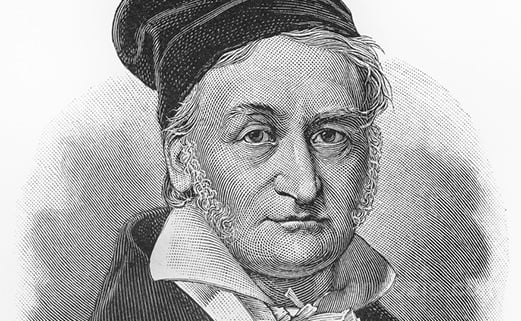Prince of Mathematicians: Who is Carl Friedrich Gauss?
He came to the world as a child of a poor family: It is not easy to summarize in one article the seventy-eight years of life of one of the greatest scientists of all time. Carl Friedrich Gauss (1777- 1855), known as the "prince of mathematicians", is one of the greatest mathematicians of all time.

Before telling you about this amazing mathematician whose life story has been the subject of movies, let's start our article with a familiar story about his childhood. This story is actually a story that all mathematics teachers should share with their students when explaining the formula for the sum of an arithmetic sequence.
What would you do if you had to add all the integers from 1 to 100? If you have a calculator, this is a tedious but easy task. But what if there isn't? Legend has it that the task of adding these numbers was given to young Carl Friedrich Gauss by his primary school teacher as punishment for his misbehavior.
Johann Carl Friedrich Gauss (30 April 1777 – 23 February 1855) was a German mathematician, geodesist, and physicist who made significant contributions to many fields in mathematics and science. Gauss ranks among history's most influential mathematicians and has been referred to as the "Prince of Mathematicians". He was director of the Göttingen Observatory and professor at the university for nearly half a century, from 1807 until his death in 1855.
Gauss did not have a calculator or computer. However, he found the correct answer within seconds. You may wonder how he does this. Write the numbers first from 1 to 100 and then below them from 100 to 1. Then collect them under each other.
It will continue as 1+100 = 101, 2+99 = 101, 3+98 = 101, 4+97 = 101… Your final total will be 50+51=101. This means you have 50 101s. 50 x 101 = 5050 and this is the answer to the question sought.
Carl Friedrich Gauss: Germany (1777–1855); Conservative, introvert, productive and ambitious. Gauss's life represents the archetypal mathematician in many ways.
Carl Friedrich Gauss: came to the world as a child of a poor family. His talents were noticed by Carl Wilhelm Ferdinand, Duke of Braunschweig, when he was 14 years old, and the Duke supported him throughout his education.
After graduating from what is now known as the Technical University of Braunschweig, he completed his education at the University of Göttingen. During this time, Gauss studied Greek, Latin, and literature. At the age of 16, he made preliminary studies on non-Euclidean geometries. In his 17s, he criticized the proofs of number theory.
By the age of 18, he had read all the works of Lagrange and Newton. During this time he also wrote and published his monumental work Disquisitiones Arithmeticae (Arithmetic Investigations), largely on number theory.
One of Gauss's proudest discoveries was figuring out how to draw a seventeen-sided polygon using only a ruler and compasses. This was one of the greatest advances in geometry since the time of the famous Greek mathematicians. Today, there is a statue of Gauss rising on a seventeen-pointed pedestal in Braunschweig, the city where he was born.
After returning from the University of Göttingen, Gauss finally received his doctorate from Helmstedt University in 1799. Meanwhile, he began to deal with polynomial equation solutions and discovered the existence of the complex number plane. This plane entered the world of mathematics as the "Gauss Plane".
Another of Gauss's discoveries was that he proved what is today called the fundamental theorem of algebra. In mathematics, the fundamental theorem of algebra is a fundamental result of the existence of roots of polynomials of complex variables.
In 1805, apart from mathematics, Gauss fell in love with a woman: Johanna Osthoff. They got married and had two children, but 4 years later his wife died of illness. Shortly after, one of his children died. The next year Gauss married Minna Waldeck, with whom he had three more children. They had a happy home life afterwards.
In 1818, he became scientific advisor to an official geodetic survey for the province of Hanover. This work inspired new mathematical theories, particularly regarding surfaces and cartography. Mathematics was not Gauss's only interest.
Studying European literature, old classics, world politics, botany, and mineralogy were also among his hobbies. Along with his native German, he could read and write Latin, English, Danish (Danish) and French.
In 1832, Gauss formed a partnership with Wilhelm Weber, one of the leading physicists of his time. They built the first electromagnetic telegraph in 1833. The first connection was between the observatory where Gauss worked in Göttingen and the Institute of Physics in Germany.
At the suggestion of Prussian scientist Alexander von Humboldt, Gauss and Weber determined measurements of the Earth's magnetic field in many regions of the world. His research on electromagnetism played a major role in the development of physical science in the 19th century.
In 1837 Weber left Göttingen for political reasons. After this, Gauss's works became less and less voluminous. Still, he continued to support other scientists. Carl Friedrich Gauss died in Göttingen on 23 November 1855.
In conclusion;
Today, Carl Friedrich Gauss's brain is kept at the Faculty of Medicine of the University of Göttingen for research. He used to say, "Mathematicians stand on each other's shoulders." The works and studies he left behind caused the mathematicians who came after him to stand on his shoulders.
We recommend that you watch the movie "Die Vermessung der Welt - Measuring the World", which is partly fictional but partly about his life.
